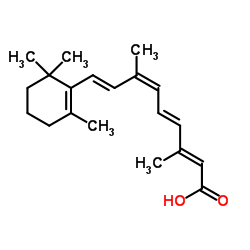5300-03-8
| Name | 9-cis-retinoic acid |
|---|---|
| Synonyms |
9-cis-Tretinoin,Alitretinoin
(9cis)-Retinoic acid Alitretinoin (2E,4E,6Z,8E)-3,7-dimethyl-9-(2,6,6-trimethylcyclohex-1-en-1-yl)nona-2,4,6,8-tetraenoic acid 9-cis-retinoic acid MFCD00270072 9Z-retinoic acid 9-cis-Tretinoin 9-cis Retinoic Acid Panretin Gel (2E,4E,6Z,8E)-3,7-dimethyl-9-(2,6,6-trimethylcyclohexen-1-yl)nona-2,4,6,8-tetraenoic acid Retinoic acid, (9cis)- 9(Z)-Retinoic acid |
| Description | 9-cis-Retinoic acid (ALRT1057), a vitamin A derivative, is a potent RAR/RXR agonist. 9-cis-Retinoic acid induces apoptosis, regulates cell cycle and has anticancer, anti-inflammatory and neuroprotection activities[1][2][3][4][5]. |
|---|---|
| Related Catalog | |
| In Vitro | 9-cis-Retinoic acid (1-10 μM; 0-5 days; CA 9-22 and NA cells) treatment significantly decreases proliferation in a dose-dependent manner in CA 9-22 and NA cells[1]. 9-cis-Retinoic acid (1 μM; 24 hours) treatment significantly increases PPARγ functional activity by >200% in CA 9-22 and NA aerodigestive cells[1]. 9-cis-Retinoic acid treatment results in the formation of a nuclear PPARγ-RXRα heterodimer supershift complex in CA 9-22 cells[1]. 9-cis-Retinoic acid inhibits proliferation and induces apoptosis in cutaneous T-cell lymphoma (CTCL) in a dose-dependent and time-dependent manner. 9-cis-Retinoic acid also induces G0/G1 cell cycle arrest by downregulation of cyclin D1. 9-cis-Retinoic acid significantly decreases phosphorylation of JAK1, STAT3, and STAT5 and downregulated Bcl-xL and cyclin D1[2]. Cell Proliferation Assay[1] Cell Line: CA 9-22 and NA cells Concentration: 1 μM, 10 μM Incubation Time: 0 day, 1 day, 3 days, 5 days Result: Significantly decreased proliferation. |
| In Vivo | 9-cis-Retinoic acid (1 mg/kg; intravenous injection; daily; for 10 days; male C57BL/6J mice) treatment significantly decreases the serum ALT and AST level, alleviates hepatic necrosis of the bile duct ligation (BDL)-mice[3]. Animal Model: Male C57BL/6J mice (6-8 weeks; 19-22 g) treatment with bile duct ligated[3] Dosage: 1 mg/kg Administration: Intravenous injection; daily; for 10 days Result: Significantly decreased the serum ALT and AST level, alleviated hepatic necrosis. |
| References |
| Density | 1.0±0.1 g/cm3 |
|---|---|
| Boiling Point | 462.8±14.0 °C at 760 mmHg |
| Melting Point | 189-191ºC |
| Molecular Formula | C20H28O2 |
| Molecular Weight | 300.435 |
| Flash Point | 350.6±11.0 °C |
| Exact Mass | 300.208923 |
| PSA | 37.30000 |
| LogP | 6.83 |
| Vapour Pressure | 0.0±2.5 mmHg at 25°C |
| Index of Refraction | 1.556 |
| Storage condition | −20°C |
| Stability | Store Dry in Freezer at -20°C for up to 1 year; in Solution at -20°C for up to 3 Months. |
| Symbol |


GHS07, GHS08 |
|---|---|
| Signal Word | Danger |
| Hazard Statements | H315-H319-H335-H360 |
| Precautionary Statements | P201-P261-P305 + P351 + P338-P308 + P313 |
| Personal Protective Equipment | Eyeshields;full-face particle respirator type N100 (US);Gloves;respirator cartridge type N100 (US);type P1 (EN143) respirator filter;type P3 (EN 143) respirator cartridges |
| Hazard Codes | T: Toxic; |
| Risk Phrases | R36/37/38;R61 |
| Safety Phrases | S26-S36/37/39-S45-S53 |
| RIDADR | NONH for all modes of transport |
| WGK Germany | 3 |
| HS Code | 2916209090 |
| HS Code | 2916209090 |
|---|---|
| Summary | 2916209090 other cyclanic, cyclenic or cyclotherpenic monocarboxylic acids, their anhydrides, halides, peroxides, peroxyacids and their derivatives VAT:17.0% Tax rebate rate:9.0% Supervision conditions:AB(certificate of inspection for goods inward,certificate of inspection for goods outward) MFN tariff:6.5% General tariff:30.0% |

